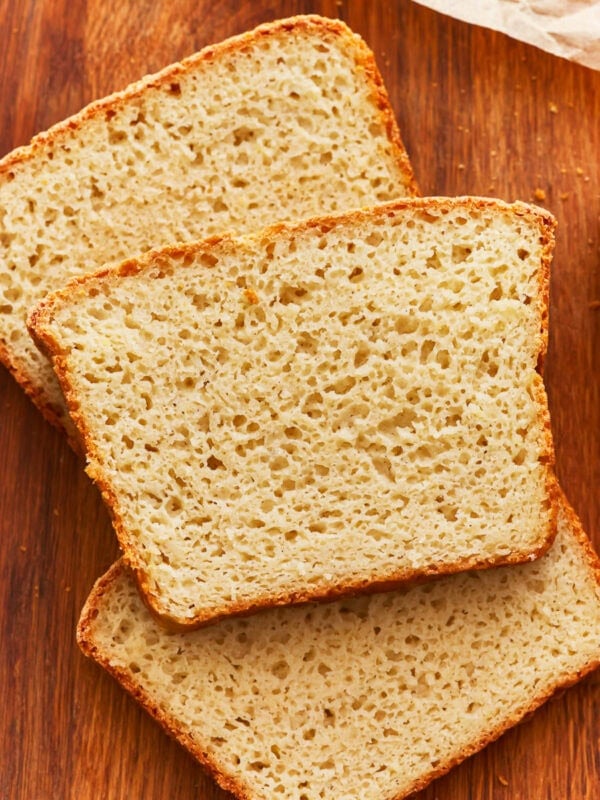This post may contain affiliate links. To learn more check my disclosure page.
This gluten-free flatbread recipe is so quick and easy to make, it had me wondering why I ever bought flatbreads at the store to begin with. Made with less than 10 ingredients and on the table in just 35 minutes, I love that I can make these fresh, hot flatbreads any day of the week. They go with just about any meal and are perfect for dipping!

Gluten-Free Flatbread Recipe
I love how simple it is to make flavorful homemade flatbread at home with this easy gluten-free flatbread recipe. Similar to my gluten-free focaccia and gluten-free naan bread, this flatbread is a versatile side that pairs well with lots of different meals. These flatbreads are naturally egg-free and can easily be made dairy-free and vegan!
Ingredients
- Gluten-Free All-Purpose Flour: I used Cup4Cup Multipurpose Flour Blend. Not all gluten-free flours are created equal. You may experience different baking results depending on the gluten-free flour blend you choose.
- Xanthan Gum: Improves the texture of the flatbreads. Check your gluten-free flour blend ingredients carefully, and only add this if your blend does not already include it.
- Baking Powder: Helps the flatbreads rise to become light and fluffy.
- Garlic Powder: Adds an earthy and savory flavor to the flatbreads.
- Dried Oregano: Adds an herbal flavor to the flatbreads.
- Salt: Enhances the flavor of the flatbreads.
- Full-Fat Plain Greek Yogurt: Adds moisture, richness, and flavor to the flatbreads. For a dairy-free version, use dairy-free Greek yogurt.
- Unsalted Butter: Adds a touch of richness to the flatbread dough. For a dairy-free version, use your favorite dairy-free butter.

Step by Step Instructions
- In a medium bowl, whisk together gluten-free flour with xanthan gum, baking powder, garlic powder, dried oregano, and salt. (pic 1)
- With an electric mixer on low speed, add yogurt and melted butter to the dry ingredients and beat on low just until combined (about 1-2 minutes). Do not overmix. Use a spatula to blend in any dry ingredients that may have settled in the bottom of the bowl. (pic 2)
- Separate the dough into 4 equal parts (this is about 165 grams of dough per flatbread). (pic 3)
- Using a rolling pin between two sheets of parchment paper (to avoid the dough sticking to the rolling pan and table), roll each ball of dough out to about ¼-inch thickness. They don’t have to be perfectly round but if you want to smooth out the edges you can with a slightly damp finger. (pic 4)
- Heat a large frying pan over low-medium heat on the stovetop. Once heated, spray with non-stick cooking spray. If the oil starts to brown too much into the pan, gently & carefully wipe it out and re-spray. Oil that’s starting to burn will transfer into the flatbread and turn the flatbread an unappetizing brown color.
- Place one flattened flatbread dough in the frying pan and heat over low-medium heat for about 2 to 3 minutes (until the bread has started to brown slightly) then flip and cook for another 2 to 3 minutes on the other side until it is fully cooked. It is important to cook these over a low-medium heat so that they don’t burn before they’re fully cooked through. They should be lightly browned all over but not starting to burn. (pics 5 & 6)

Tips and Suggestions
- Be sure to use certified gluten-free all-purpose flour.
- Do not sprinkle extra gluten-free flour on your work surface to prevent the dough from sticking. Extra flour will lead to the dough drying out and not sticking together.
- If the dough is sticking to your hands, wet your hands just slightly to prevent the dough from sticking. Not too much water though as you don’t want the dough soaking up extra fluid.
- Measure your flour in grams or using the spoon-and-level method to avoid dry flatbreads.
My Dough Is Too Wet/Dry. What Should I Do?
If your dough is too wet, add a tablespoon of gluten-free flour at a time until it reaches a manageable consistency. If it is too dry, add a tablespoon of water at a time until it reaches the desired consistency. The dough should be tacky but not sticky.

Can I Make This Without A Rolling Pin?
Yes! You can place the flatbreads between two pieces of parchment paper and press them out into a flatbread shape with your hands.
What Is The Best Pan To Use To Cook Flatbreads?
A cast iron skillet or a nonstick pan are both good options for cooking these flatbreads.
Storage Instructions
Store gluten-free flatbread in an airtight container at room temperature for up to 3 days. You can also freeze them with parchment between to prevent them from sticking together for up to 3 months. Let thaw overnight in the refrigerator before enjoying.

More Gluten-Free Bread Recipes to Try!
- Gluten-Free Focaccia
- Easy Gluten-Free Bread
- Gluten-Free Bread Machine Bread
- Gluten-Free Naan Bread
- Gluten-Free Dinner Rolls
Gluten-Free Flatbread

Ingredients
- 2 cups gluten-free all-purpose flour with xanthan gum
- 2 teaspoons baking powder
- 1 teaspoon garlic powder
- 1 teaspoon dried oregano
- ½ teaspoon salt
- 2 cups full-fat plain Greek yogurt
- 1 tablespoon unsalted butter, melted but not too hot
Instructions
- In a medium bowl, whisk together gluten-free flour with xanthan gum, baking powder, garlic powder, dried oregano, and salt.
- With an electric mixer on low speed, add yogurt and melted butter to the dry ingredients and beat on low just until combined (about 1-2 minutes). Do not overmix. Use a spatula to blend in any dry ingredients that may have settled in the bottom of the bowl.
- Separate the dough into 4 equal parts (this is about 165 grams of dough per flatbread).
- Using a rolling pin between two sheets of parchment paper (to avoid the dough sticking to the rolling pan and table), roll each ball of dough out to about ¼-inch thickness. They don’t have to be perfectly round but if you want to smooth out the edges you can with a slightly damp finger.
- Heat a large frying pan over low-medium heat on the stovetop. Once heated, spray with non-stick cooking spray. If the oil starts to brown too much into the pan, gently & carefully wipe it out and re-spray. Oil that’s starting to burn will transfer into the flatbread and turn the flatbread an unappetizing brown color.
- Place one flattened flatbread dough in the frying pan and heat over low-medium heat for about 2 to 3 minutes (until the bread has started to brown slightly) then flip and cook for another 2 to 3 minutes on the other side until it is fully cooked. It is important to cook these over a low-medium heat so that they don’t burn before they’re fully cooked through. They should be lightly browned all over but not starting to burn.
Notes
- Be sure to use certified gluten-free all-purpose flour.
- Do not sprinkle extra gluten-free flour on your work surface to prevent the dough from sticking. Extra flour will lead to the dough drying out and not sticking together.
- If the dough is sticking to your hands, wet your hands just slightly to prevent the dough from sticking. Not too much water though as you don’t want the dough soaking up extra fluid.
- Measure your flour in grams or using the spoon-and-level method to avoid dry flatbreads.
- To store: Place the flatbreads in an airtight container at room temperature for up to 3 days.
- To freeze: Place the flatbreads in an airtight container or Ziplock bag with parchment between them to prevent sticking for up to 3 months.
Nutrition
Nutrition information is automatically calculated, so should only be used as an approximation.














Hi, I’m from South Africa and can’t get the gluten-free flour you use.
Is it possible to let me know what the ingredients of the flour mix is? I can then compare it to my mixture.
Thanks
Surina
Hi Surina, this page lists all of the gluten-free flours we recommend: https://www.mamaknowsglutenfree.com/best-gluten-free-flours/
Unfortunately, we do not know the exact proportions of each ingredient. You may have success with this DIY recipe from the Loopy Whisk (click here), however, we have not personally tried it with any of our recipes.
I had to pretty much double the amount of flour I used, and ended up having to make more of a naan type of bread than a flatbread.
What brand of flour do you use? I’m certain I measured everything correctly but my dough was too gooey to work with. what consistency do you want with these before trying?
Hi Bobby, we used Cup4Cup Multipurpose Flour Blend for this recipe! Please reference the step-by-step photos for examples of how the dough should look.
Can non-dairy yogurt be used?
My son is on gluten free dairy free diet
Thank you
Sure!